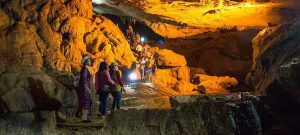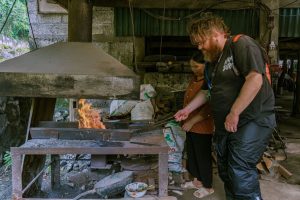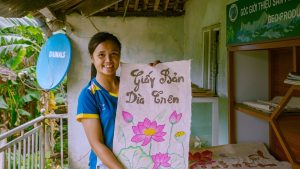Cao Bang
Cao Bang is a stunning province in northeastern Vietnam, bordering China to the north and east and Ha Giang to the west. Known for its mountain passes, dramatic karst scenery, and quiet roads, it’s a paradise for motorbike riders seeking Vietnam’s wild side.
While most travellers know Cao Bang for the famous Ban Gioc Waterfall, that’s only the beginning. The province is packed with hidden gems, making it a peaceful, less-touristed alternative to Ha Giang.
Getting to Cao Bang with Motorbike
Cao Bang city sits about 270 km north of Hanoi, making it a long but doable day ride. Most riders, however, take a more relaxed route – stopping overnight in Ba Be Lake or Bac Son Valley, both worth a visit for their lakes, caves, and rice terraces.
If you’re riding from Ha Giang, the most scenic route is via Bao Lac, following the Chinese border. The ride from Dong Van & Meo Vac to Bao Lac is relatively short but full of viewpoints and ethnic minority villages, so it’s best enjoyed at an easy pace rather than rushing to Cao Bang city in a single day.

Where to Stay
Because the province is large, it’s common to spend two to three nights exploring different areas.
- Cao Bang City: A comfortable base with plenty of hotels, restaurants, and nightlife.
- Bao Lac: A simple but handy stopover when linking Ha Giang and Cao Bang.
- Ban Gioc Waterfall: Great riverside homestays near the falls – quiet at night but perfect for relaxing after a long day’s ride.
- Thung Nham (God’s Eye Mountain): Just outside the city, this area offers glamping and homestays surrounded by small lakes and karst peaks – ideal for sunrise or sunset rides.
Ban Gioc Waterfall
Straddling the Vietnam – China border, Bản Giốc is the widest waterfall in Vietnam – over 300 m across and 30 m high. It’s one of the country’s most photogenic natural landmarks.
You can’t swim here due to the border, but small bamboo boats offer close-up views right beneath the falls.
Best time to visit: Late autumn (September – November), when the rains ease but the water volume is still impressive, and the surrounding rice fields turn golden.

God’s Eye Mountain
Just north of Cao Bang City lies God’s Eye Mountain, a surreal plateau with a giant hole through its limestone peak – a must-see for photographers.
It’s become a popular glamping spot with large safari-style tents, BBQ dinners, and peaceful countryside views. While not the cheapest stay, it’s a memorable experience surrounded by mountains, lakes, and open air – perfect for short rides at sunrise or dusk.
Khau Coc Cha Pass
An icon of northern Vietnam’s winding roads, Khau Coc Cha Pass features 14 tight switchbacks that spiral down into a lush valley.
It’s best approached west to east (from Ha Giang toward Cao Bang) to enjoy the full panorama. Riders can hike about 45 minutes up a small trail for the famous bird’s-eye photo of the pass – one of Vietnam’s most jaw-dropping views.

Pac Bo
Pac Bo is home to Coc Bo Cave, where Ho Chi Minh lived in 1941 after returning from exile in China. It’s a site of deep historical significance, complete with a shrine and museum.
The surrounding area features turquoise pools and limestone hills, making it scenic as well as cultural. This is also the starting point of the legendary Ho Chi Minh Highway, which stretches the entire length of Vietnam.
Tiger Cave
Located near Ban Gioc, Tiger Cave is one of Cao Bang’s most accessible and impressive caves. Stretching over 3 km, visitors can explore the first kilometre, which is well-lit and easy to walk.
Entry is just 40,000 VND, making it an easy and rewarding side trip.

Phuc Sen – Knife Making Village
Between Cao Bang City and Ban Gioc lies Phuc Sen, a small village famous for its centuries-old blacksmithing tradition. Over half the 400 houses here are blacksmiths, crafting knives from recycled materials.
Stop by a workshop to see the process and pick up a hand-forged knife – a unique local souvenir (just maybe not one for carry-on luggage!).

Phia Thap – Incense Village
Just a short detour from Phuc Sen, Phia Thap is known for its traditional incense-making. You’ll see families rolling colorful sticks by hand and drying them in the sun – a quick, photogenic stop on your ride to Ban Gioc.
Dia Tren – Paper Making Village
Another nearby craft village, Dia Tren, keeps the ancient art of handmade paper alive. If you’re lucky, a local guide may explain the process in English. Even without translation, it’s fascinating to see – and you can buy local artwork made on this traditional paper.

Summary
Cao Bang is one of Vietnam’s most underrated motorbike destinations. With its towering karst peaks, cultural villages, and historic sites, it’s every bit as scenic as Ha Giang but far less crowded.
A few days here pairs perfectly with a Ha Giang and Cao Bang loop, giving riders the full experience of northern Vietnam’s raw beauty.
Whether you come for Ban Gioc waterfall, Khau Cac Cha’s switchbacks, or simply to escape the tourist trail, Cao Bang offers unforgettable roads and authentic local life.
Related Routes
There are many routes in the north of Vietnam which allow a trip to Cao Bang, you can see them here.
Reviews
Share your experience and help other ridersNo reviews yet. Be the first to review!

Leave a Comment & Review